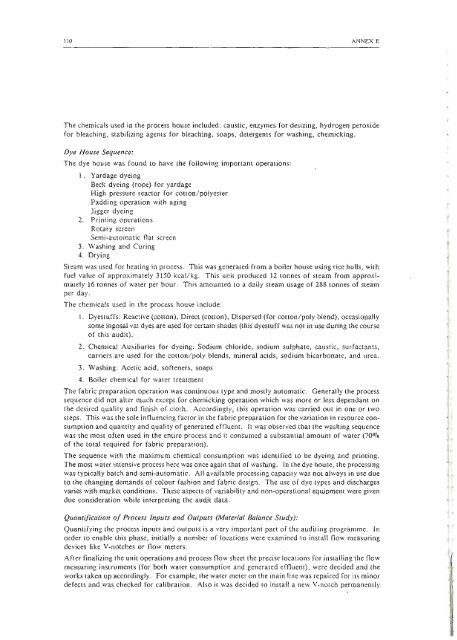Contributor, The Textile Industry and the Environment, UNEP
Contributor, The Textile Industry and the Environment, UNEP
Contributor, The Textile Industry and the Environment, UNEP
Create successful ePaper yourself
Turn your PDF publications into a flip-book with our unique Google optimized e-Paper software.
110 ANNEX E<br />
<strong>The</strong> chemicals used in <strong>the</strong> process house included: caustic, enzymes for desizing, hydrogen peroxide<br />
for bleaching, stabilizing agents for bleaching, soaps, detergents for washing, chemicking.<br />
Dye House Sequence:<br />
<strong>The</strong> dye house was found to have <strong>the</strong> following important operations:<br />
I. Yardage dyeing<br />
Beck dyeing (rope) for yardage<br />
High pressure reactor for colton/polyester<br />
Padding operation with aging<br />
Jigger dyeing<br />
2. Printing operations<br />
Rotary screen<br />
Semi-automatic flat screen<br />
3. Washing <strong>and</strong> Curing t<br />
4. Drying<br />
Steam was used for heating in process. This was generated from a boiler house using rice hulls, with<br />
fuel value of approximately 3150 kcal/kg. This unit produced 12 tannes of steam from approximately<br />
16 tonnes of water per hour. This amounted to a daily steam usage of 288 tonnes of steam<br />
per day.<br />
<strong>The</strong> chemicals used in <strong>the</strong> process house include:<br />
I. Dyesmffs: Reactive (colton), Direct (cotton), Dispersed (for cotton/poly blend), occasionally<br />
some ingosal vat dyes are used for cert.ain shades (this dyestuff was not in use during <strong>the</strong> course<br />
of this audit).<br />
2. Chemical Auxiliaries for dyeing: Sodium chloride, sodium sulphate, caustic, surfactants,<br />
carriers are used for <strong>the</strong> cotlon/poly blends, mineral acids, sodium bicarbonate, <strong>and</strong> urea.<br />
3. Washing: Acetic acid, softeners, soaps<br />
4. Boiler chemical for water treatment<br />
<strong>The</strong> fabric preparation operation was continuous type <strong>and</strong> mostly automatic. Generally <strong>the</strong> process<br />
sequence did not alter much except for chemicking operation which was more or Jess dependant on<br />
<strong>the</strong> desired quality <strong>and</strong> finish of cloth. Accordingly, this operation was carried out in one or two<br />
steps. This was <strong>the</strong> sale inf1uencing factor in <strong>the</strong> fabric preparation for <strong>the</strong> variation in resource consumption<br />
<strong>and</strong> quantity <strong>and</strong> quality of generated effluent. [t was observed that <strong>the</strong> washing sequence<br />
was <strong>the</strong> most often used in <strong>the</strong> entire process <strong>and</strong> it consumed a substantial amount of water (70070<br />
of <strong>the</strong> total required for fabric preparation).<br />
<strong>The</strong> sequence with tne maximum chemical consumption was identified to be dyeing <strong>and</strong> printing.<br />
<strong>The</strong> most water intensive process here was once again that of washing. In <strong>the</strong> dye house, <strong>the</strong> processing<br />
was typically batch <strong>and</strong> semi-automatic. All available processing capacity was not always in use due<br />
to <strong>the</strong> ch.anging dem<strong>and</strong>s of colour fashion <strong>and</strong> fabric design. <strong>The</strong> use of dye types <strong>and</strong> discharges<br />
varies with market conditions. <strong>The</strong>se aspects of variability <strong>and</strong> non-operational equipment were given<br />
due consideral ion while interpreting <strong>the</strong> audit data.<br />
Quantification of Process Inputs <strong>and</strong> Outputs (Material Balance Study):<br />
Quantifying <strong>the</strong> process inputs <strong>and</strong> outputs is a very important part of <strong>the</strong> auditing programme. In<br />
order to enable this phase, initially a number of locations were examined to install flow measuring<br />
devices like V-notches or flow meters.<br />
After finalizing <strong>the</strong> unit operations <strong>and</strong> process f10w sheet <strong>the</strong> precise locations for installing <strong>the</strong> flow<br />
measuring instruments (for both water consumption <strong>and</strong> generated eff1uent), were decided <strong>and</strong> <strong>the</strong><br />
works taken up accordingly. For example, <strong>the</strong> water meter on <strong>the</strong> main line was repaired for its minor<br />
defects <strong>and</strong> was checked for calibration. Also it was decided 10 install a new V-notch permanently<br />
1

















